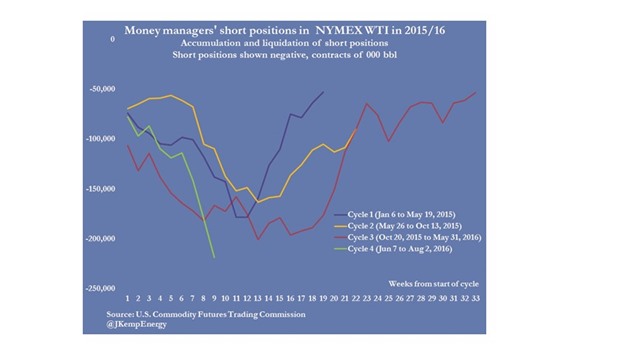The enormous concentration of bearish short positions in US crude oil futures and options contracts by hedge funds and other money managers left the market ripe for a short-covering rally.
The rebound in futures prices, with the September WTI contract up by 10% since August 2, has all the characteristics of a short-covering rally (“Hedge fund short covering probably accounts for oil rally”, Reuters, August 8).
Price moves in the next few trading sessions should give some indication about whether hedge funds have embarked on the liquidation phase of the shorting cycle or are extending their short positions even further.
By August 2, the most recent data available, hedge funds and other money managers had accumulated short positions equivalent to 248mn barrels in the main futures and options contracts linked to WTI.
The number of short positions had increased from a recent low of just 71mn barrels on May 31, according to an analysis of data published by the US Commodity Futures Trading Commission.
The accumulation of an additional 178mn barrels of short positions coincided with a decline in WTI futures prices of just over $10 per barrel from $49.93 to $39.51.
CFTC data shows there have been three previous cycles of short-selling by hedge funds since the start of 2015 and they now appear to be well into a fourth.
The accumulation and then liquidation of short positions during each cycle on NYMEX has corresponded roughly with the fall and then rise in WTI prices.
The current short-selling already appeared fairly mature by August 2 which raised the prospect of an imminent turning point.
During the three previous cycles, hedge funds had amassed their maximum short position after 11 weeks, 13 weeks and 13 weeks, respectively. The current short-selling cycle is already nine weeks old.
In the three previous cycles, hedge fund short positions in NYMEX WTI peaked at 178mn barrels, 163mn and 201mn.
The current short position has already exceeded these and hit 219mn barrels.
The current cycle of short-selling is still less mature than previous cycles when they hit their turning point and switched from accumulation to liquidation of short positions.
But it has also been more aggressive with a record short position in NYMEX WTI established at a much faster pace than during the previous cycles.
As the number of short positions has increased in the fourth cycle, WTI prices have declined, falling at much the same rate as seen during the second and third cycles. Prices might have been expected to fall even further and even faster, given the accompanying rapid accumulation of a record short position.
The persistence of many hedge funds with long positions probably explains why prices have been stronger than during previous cycles when a roughly similar number of short positions has been established.
From a price perspective, the current cycle of short selling appears less mature than previous cycles, which would suggest it could have another 2-4 weeks before peaking.
But the current cycle appears to have developed on an accelerated timetable compared with prior cycles so it may already have reached or be very near its turning point.

John Kemp is a Reuters market analyst. The views expressed are his own.
